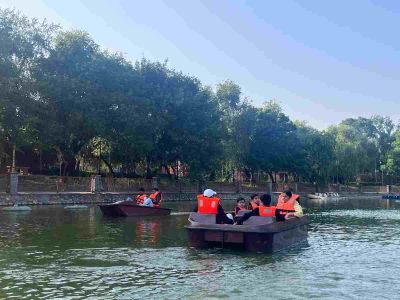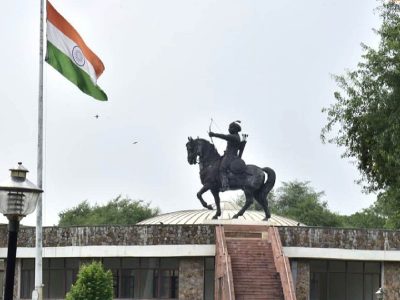Even though it was February 1958, the mood in the newly built Sapru House in the capital was warm. Understandably so, as the President of Vietnam, Ho Chi Minh, was being felicitated there in a packed hall. To add to the occasion, celebrated Punjabi poet Amrita Pritam recited her moving poem on the struggles of the Vietnamese people.
Established in 1955, this year marks a landmark moment for Sapru House as it completes its 70-year journey. Regarded as India’s first think tank institute dedicated to foreign policy, it has hosted numerous dignitaries and important seminars. The plaques inside the red and white sandstone building on Barakhamba Road reveal that it was built through crowdfunding. Several maharajas and prominent personalities, including Dr Rajendra Prasad, Sardar Vallabhbhai Patel, and Maulana Abul Kalam Azad, contributed generously to its construction.
“Even Pt Jawaharlal Nehru contributed Rs 500 for the making of Sapru House. It is sheer chance that some of the most prominent Kashmiri personalities of the past—Tej Bahadur Sapru, HN Kunjru, and Pt Nehru— were at the forefront of establishing the headquarters of the Indian Council of World Affairs (ICWA),” says Mahendra Ved, author of @ 75 AS i SAW IT. In 1955, then Prime Minister Jawaharlal Nehru inaugurated Sapru House as the headquarters of ICWA, which had been founded in 1943.
Sapru house and Rajghat
Spread over nearly two acres, Sapru House boasts a striking architectural design that integrates a stupa-style dome, a gateway reminiscent of Islamic aesthetics, and pillars of distinct Hindu origins. It was designed by Sydney Percy-Lancaster, the then head of the Central Public Works Department. An Anglo Indian from Meerut, Percy-Lancaster was also the landscape designer of Rajghat. “The ICWA was not founded in a spirit of rivalry with any institution; the only motivation behind its creation was the need for a thorough and factual study of world problems from the Indian point of view,” write former IFS officers TCA Raghavan and Vivek Mishra.
Also read: The forgotten architects: Mughal women who shaped Delhi’s skyline
If Sapru House became the nerve centre of Indian foreign policy, much of the credit goes to Prof A Appadorai, a distinguished scholar of international relations and foreign policy. Associated with Sapru House since its early days, he shared its formative experiences with this writer in 1988 at his Babar Road residence. At the time, he lamented that such a great institution had become the fiefdom of a local political leader. Thankfully, Sapru House is now free from those shackles. Prof Appadorai, who also taught at Jawaharlal Nehru University (JNU), was widely respected for his insightful analyses of India’s foreign policy challenges and opportunities.
However, Sapru House is not solely about diplomacy and foreign relations. Until the 1990s, it also served as a venue for concerts, poetry readings, and Punjabi theatre performances.
Osting Begum Akhtar, ‘Dinkar’ and Shiv Batalvi
In the early 1960s, Sapru House was practically the only venue in the capital for music and drama events. Other prominent halls in the Mandi House area, such as Kamani, Shriram Centre, and FICCI, came much later. The legendary Begum Akhtar performed countless times in Delhi, including many successful programmes at Sapru House.
In December 1964, she delivered what is considered her first performance in Delhi at this very venue. Film writer Satish Chopra recalls that the 400-seat auditorium was packed to capacity with eager listeners from all walks of life. The programme began around 9 PM, and each ghazal, thumri, and dadra lasted over half an hour. Throughout the evening, the audience repeatedly requested Ae Mohabbat Tere Anjaam Pe Rona Aaya, but the host kept postponing it, saying it would be sung at the end. Finally, at around 1:30 AM, she performed the iconic ghazal in her inimitable style, leaving the audience mesmerised and fulfilled.
Just days before his passing in Chennai on April 24, 1974, Ramdhari Singh ‘Dinkar’ visited Sapru House to participate in a DCM Kavi Sammelan. The gathering also featured Harivansh Rai Bachchan and poet Neeraj. In a packed auditorium, Dinkar recited his famous poems, Bharat Ka Yeh Reshmi Nagar… and Samar Shesh Hai…. “Although his health was failing, he recited Samar Shesh Hai twice due to the audience’s enthusiastic demand,” recalls Prof Pratap Sehgal, a long-time faculty member of Delhi University. In fact, Sapru House regularly hosted Kavi Sammelans until the 1980s.
More than half a century has passed since Shiv Batalvi, one of Punjabi literature’s most powerful poets, captivated audiences at Sapru House. In 1969, he recited his poetry to a spellbound crowd, swaying to his words. Dressed in a simple kurta-pyjama and Kolhapuri chappals, he wept as he recited his compositions, reflecting the deep emotionality of his verse. At the peak of his popularity, he opened his reading with his famous poem Mainu tera shabab lai baitha.
Dr Harmeet Singh, then a student at Khalsa College and later its principal, recalls attending this unforgettable evening along with friends from Paharganj and Karol Bagh.
Also read: Maharashtra’s bond with Nutan Marathi School: A legacy of cultural pride
For the past few years, Sapru House has functioned as an exclusive research hub for diplomacy, receiving generous support from the Ministry of External Affairs. “There was a time when Jagmohan, Delhi’s strongman, used to sit in the Sapru House library for hours,” reminisces senior journalist Mahendra Ved. Though its role has evolved, the legacy of Sapru House as a centre for both intellectual discourse and cultural expression remains unshaken.
The writer is a Delhi-based senior jour nalist and author of two books ‘Gandhi’s Delhi: April 12, 1915-January 30, 1948 and Beyond’ and ‘Dilli Ka Pehla Pyar – Connaught Place’




